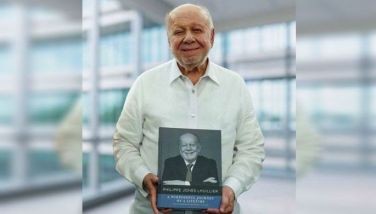Role of the Filipino leader in the development of the Asia-Pacific community
January 25, 2007 | 12:00am
The role of a leader is often shaped by the characteristics of the people being led. How do we define a Filipino? In an archipelagic country composed of 7,107 islands with more than 110 ethno-linguistic groups, each with its own cultural history, and which is strategically situated at the entrance to Asia from the Pacific, is there even such a thing as a unique Philippine identity? Based on initial research conducted by the UP DNA Analysis Laboratory that aims to study the relationships of different indigenous groups such as the Ivatans of Batanes, Bugkalots, Kalangoyas and migrant Ibalois of Nueva Vizcaya, Kalingas of Kalinga province, Aetas of Bataan, Atis of Panay Island and Guimaras, six groups of Mangyans in Oriental Mindoro and Maranaos in Lanao del Norte, as well as urban groups, e.g. Tagalogs, Bisayas, Ilocanos, Ilonggos, there are certain traits that are common to all groups that may help identify and define the role of the Filipino leader.
First is inherent multipluralism, i.e. the ability of different groups to co-exist peacefully in one geographic area. For instance, the seven tribes of Mangyans of Oriental Mindoro, i.e. the Buhids, Tawbuhids, Hanunoos, Irayas, Tadyawans, Batangans and Alangans, possess their own language, history, beliefs and cultural traditions, and yet live together without dispute. On a larger scale, the general populations of Tagalogs have co-existed with Bisayans, Ilocanos, Ilonggos and Dabawenos without conflict.
Multipluralism at work is best exemplified by the Edsa revolution, where Filipinos from all walks of life and different religious, political and ideological beliefs worked together as one to oust a dictatorial regime without bloodshed.
Second, is the capacity to adapt to new environments and the "can do" attitude, even under challenging conditions. Integral to adaptability is creativity and ingenuity. Take, for example, the Ivatans of Batanes, which lies at the junction of the South China Sea and the Pacific Ocean and therefore experiences the worst typhoons. And yet, the Ivatans have managed to live in Batanes by building their houses out of limestone, planting mainly root crops with camote as their staple food rather than rice, and developing numerous means to preserve food. How about the Ifugaos who had built the rice terraces which is not only a work of art and considered the eighth wonder of the world, but is a highly effective system of rice irrigation given the available mountainous terrain?
On a larger scale, the adaptability of Filipinos is exemplified by the numerous overseas Filipinos who are living in all parts of the world. Unlike other cultures which tend to keep to themselves and form their own communities, Filipinos are known to integrate themselves into the "host country." On a local level, the Filipinos’ ability to cope with adversity is remarkable, e.g. vendors selling umbrellas when it starts to rain; children selling slippers when it starts to flood; people living in flooded areas taking a banca to work; students lining up in photocopying shops to obtain "cheap copies" of their textbooks; mothers cooking instant mami noodles instead of rice to make ends meet; and women setting up small variety stores in almost every corner of the neighborhood.
Third, is the capacity to work together in a team as shown by the inherent bayanihan spirit. For example, this author has witnessed the community of Ivatans help out in preparing the burial of a member, the Kalangoyas assist in the wedding preparations of a couple and the Atis of Aklan help a family build their home. There is a prevailing spirit of camaraderie and teamwork in the communities which is crucial for nation-building and regional development.
Given these characteristics, it is evident that the Filipino leader can contribute significantly to the development of the Asia-Pacific region through his multipluralistic perspective, respect for democracy, adaptability to current and future challenges using his skills and creativity, and with a capacity to work in a team of diverse players striving for the common good.
Dr. Maria Corazon A. de Ungria currently heads the DNA Analysis Laboratory of the Natural Sciences Research Institute, University of the Philippines, Diliman campus (www.dnaforensic.org). This laboratory is currently promoting the development of forensic DNA technology in the country as well as the conduct of genetic studies of different Philippine populations. Since 1998, the UP-NSRI DNA lab has been accepting requests for DNA typing in disputed parentage cases as well as assistance in criminal cases. Dr. De Ungria has received recognition from the scientific community as well as lay organizations for her various research endeavors, the results of which are aimed at putting science at the service of society. Her awards include the Outstanding Young Scientist (OYS) award in 2003 from the National Academy of Science and Technology (NAST) and the UP Chancellor’s Gawad Hall of Fame for Best REPS in Research in 2005 from the University of the Philippines (Diliman). In 2005, Dr. De Ungria was the only woman named one of The Outstanding Young Men (TOYM). E-mail at [email protected]
First is inherent multipluralism, i.e. the ability of different groups to co-exist peacefully in one geographic area. For instance, the seven tribes of Mangyans of Oriental Mindoro, i.e. the Buhids, Tawbuhids, Hanunoos, Irayas, Tadyawans, Batangans and Alangans, possess their own language, history, beliefs and cultural traditions, and yet live together without dispute. On a larger scale, the general populations of Tagalogs have co-existed with Bisayans, Ilocanos, Ilonggos and Dabawenos without conflict.
Multipluralism at work is best exemplified by the Edsa revolution, where Filipinos from all walks of life and different religious, political and ideological beliefs worked together as one to oust a dictatorial regime without bloodshed.
Second, is the capacity to adapt to new environments and the "can do" attitude, even under challenging conditions. Integral to adaptability is creativity and ingenuity. Take, for example, the Ivatans of Batanes, which lies at the junction of the South China Sea and the Pacific Ocean and therefore experiences the worst typhoons. And yet, the Ivatans have managed to live in Batanes by building their houses out of limestone, planting mainly root crops with camote as their staple food rather than rice, and developing numerous means to preserve food. How about the Ifugaos who had built the rice terraces which is not only a work of art and considered the eighth wonder of the world, but is a highly effective system of rice irrigation given the available mountainous terrain?
On a larger scale, the adaptability of Filipinos is exemplified by the numerous overseas Filipinos who are living in all parts of the world. Unlike other cultures which tend to keep to themselves and form their own communities, Filipinos are known to integrate themselves into the "host country." On a local level, the Filipinos’ ability to cope with adversity is remarkable, e.g. vendors selling umbrellas when it starts to rain; children selling slippers when it starts to flood; people living in flooded areas taking a banca to work; students lining up in photocopying shops to obtain "cheap copies" of their textbooks; mothers cooking instant mami noodles instead of rice to make ends meet; and women setting up small variety stores in almost every corner of the neighborhood.
Third, is the capacity to work together in a team as shown by the inherent bayanihan spirit. For example, this author has witnessed the community of Ivatans help out in preparing the burial of a member, the Kalangoyas assist in the wedding preparations of a couple and the Atis of Aklan help a family build their home. There is a prevailing spirit of camaraderie and teamwork in the communities which is crucial for nation-building and regional development.
Given these characteristics, it is evident that the Filipino leader can contribute significantly to the development of the Asia-Pacific region through his multipluralistic perspective, respect for democracy, adaptability to current and future challenges using his skills and creativity, and with a capacity to work in a team of diverse players striving for the common good.
BrandSpace Articles
<
>
- Latest
Latest
Latest
September 30, 2024 - 8:00am
September 30, 2024 - 8:00am
September 3, 2024 - 1:00pm
September 3, 2024 - 1:00pm
June 10, 2024 - 11:45am
June 10, 2024 - 11:45am
Recommended





























